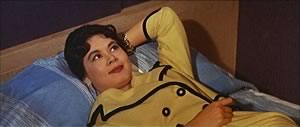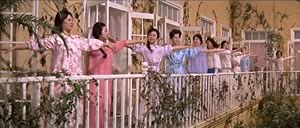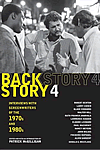Archive for October 2006
This, that, and the other
1) People who know Kristin primarily as a film scholar probably don’t know that she’s also the librarian/curator of the P. G. Wodehouse papers. Every couple of years she goes to England to organize and preserve the papers that the family has acquired since her last visit. She first worked with the papers when she wrote her book on Wodehouse, Bertie Proposes, Jeeves Disposes; or, Le Mot Juste, an appreciation of the inimitable Wooster novels. For the last few days Kristin has been there working on the collection, and out of the range of the Internet; so no new entries from her. When she returns, expect a followup on her “How to read the box-office figures” post.
2) During her absence I’ve been busy with research projects. One involves scene transitions in Hollywood movies. When Kristin, Janet Staiger, and I were working on the book, The Classical Hollywood Cinema, I got interested in how movies moved the viewer smoothly from one scene to the next. Often, we found, a line of dialogue, a sound, or an image at the very end of Scene A somehow linked to Scene B. We called these “hooks,” and talked a little about them in the book.
Recently I got curious about the problem again and as I was thinking about it, I saw a piece by Karl Iglesias, called “8 Ways to Hook the Reader,” Creative Screenwriting 13, 4 (2006), 48-49. (It doesn’t seem to be available online.) Igelesias spells out various ways in which screenwriters tie scenes together. Interestingly, our term hook seems to have entered screenwriters’ parlance a little bit.
I gave a rather sketchy talk on the question here at Madison last Thursday, and got helpful feedback from faculty and grads. Seems like everybody had a good example, from Jerry Lewis movies to The Family Guy. So I hope to develop this talk into a lecture I can give elsewhere. Eventually I expect it will end as an online essay elsewhere on this site.

Les Belles

Les Belles
3) My other current research project is looking into the development of anamorphic widescreen filmmaking in Hong Kong. In the early 1960s Shaw Bros. introduced ShawScope, a system similar to CinemaScope’s sprawling format. I’m interested in how directors used this new technology, and whether they followed the same paths as Americans did in working with CinemaScope. Did ShawScope slow up their cutting or staging? Did they find alternative ways to compose for this wide format?
Despite the rather tedious plots, I’m enjoying watching the films because they’re so striking at the level of lighting and color design. If you’re curious, have a look at Les Belles (1961) or The Love Eterne (1963). Really stunning color coordination, with both saturated tones and pastels popping off the screen–so different from the murky monochrome we like now. To get such brilliant, almost shadowless imagery in a period of slow film (ASA 50!), you have to drench your sets in light. How can actors remain so chipper when they’re blasted by so much light and heat? The crew had to wear sunglasses when working on these movies. This article is for a collection of essays called Widescreen Worldwide, edited by John Belton and Sheldon Hall.
4) My old friend Brian Rose writes to tip me off to Malcolm Gladwell’s New Yorker article on Epagogix, the software program that purports to predict what films will be commercial hits. This program has been flashing into view in the trade papers over the last few years, but Gladwell (aka Mr Blink) is the first to give it long and detailed discussion. I hope to assimilate it over the next few days and maybe Kristin or I will blog about it.
5.) As a new blogger, I’m still learning a lot. (Okay, you already can tell that.) But as I scan our Statistics counter for this site, I’m impressed all over again by the sheer weirdness of the Web.
Take the keywords that bring people to our site. I expect to see our names, Film Art, Scorsese, and so on. But I have to admire any search engine that can fling onto our site someone typing the following strings:
jack vermee
bonfire
lingua film di toto’
Christian film
zizek mao
Chinatown first act
and my current favorite:
where can I find photos of jerry van dyke
Of course now that I’ve listed these topics, I expect a lot of repeat business for them.
Back to THE DEPARTED
My first post on Scorsese’s Departed has started a passionate and pretty discerning discussion over on Jim Emerson’s Scanners blog, so I’ve joined in. You can read the thread, including my horrendously long comment, here.
In the kitchen with Benton, Hill, Kasdan, et al.
DB here:
I’ve never understood why many people in film studies ignore what practicing filmmakers tell us about their work. If we want to know about technique, form, and the creative process, we should understand filmmakers’ craft knowledge, the tricks of their trade. Filmmakers know an awful lot, and we benefit from listening to them.
So books of interviews can be quite valuable. They take us into the kitchen and let us watch chefs at work. Sometimes they follow recipes but just as often they throw things together with inspired, or disastrous, results.

Among the best of the interview books is Pat McGilligan’s Backstory series, about screenwriters and their craft. Backstory 4, just out from the University of California Press, is an addictive read, and I recommend it. McGilligan has done a wonderful job assembling these interviews, most of which he also conducted. You can’t fail to learn about filmmaking, and along with that, the wit of people who use language for their living just cheers you up. A few samples out of many:
Walter Hill: “Shoot me as the Antichrist, but I never much liked the Beatles.”
Paul Mazursky: “Voice-overs are like a good drug.”
Donald Westlake: “People shouldn’t be handed a camera until they reach the age of reason.”
Alvin Sargent: “I hardly ever finish books. You know, Paper Moon is adapted from a book, and I truly didn’t read the last part of it. I just couldn’t read that book any more. I got bored.”
John Milius: “Our whole world, our whole culture, is like a giant high-school dance.”
Westlake again: “David Hockney is the only thing that’s ever been improved by being moved to Los Angeles.”
I’m especially glad that McGilligan included two of my favorite novelists. Elmore Leonard comes off as good-humoredly disillusioned with the screenwriting process. Just as important, there’s an enlightening interview with the prolific but still too little celebrated Donald E. Westlake. Westlake is known for his comic crime novels, but even better, methinks, is his hard-boiled fiction signed by Richard Stark. The Stark novels center on the professional thief Parker, and they’re unsentimental, stripped to the bone, and formally quite adventurous. One thing we learn from Backstory 4 is that one of the best Parker novels, The Jugger, was the putative source for Godard’s Made in USA. Westlake: “such a rotten movie.”
The more predictable payoff
DB again:
A story in today’s New York Times highlights a point I’ve made elsewhere on this site (“Down in the Valleys”) and in The Way Hollywood Tells It. My claim is that scholars, journalists, and moviegoers have come to identify contemporary Hollywood with stratospherically budgeted blockbuster movies. Several films scholars have gone on to suggest that the megapicture has redefined moviemaking. If the studio era, pre-1960, was a “classical” filmmaking era, perhaps we’re now in a post-classical one, when principles of story and style have collapsed.
Now I don’t think that tentpole pictures stray much beyond the classical norms. But even if they did, the program pictures, released week in and week out, do so quite seldom. In addition, I argued that the programmers are more reliable as investments exactly because they’re easy to assimilate. A breakout midrange picture like The Devil Wears Prada is a good example. Did anybody out there find it fragmented, postmodern, or incoherent?
Today’s NYT story is about the rise of hedge funds and other investment instruments that are becoming more involved in film financing. The relevant quote is: “A result for moviegoers is that they could begin to see even more thrillers, comedies, and horror movies at the multiplex–the types of movies Wall Street favors because of their more predictable payoff.” The relevant player is Joel Silver, who has just signed on to make “a mix of horror, comedy, and action movies that will cost $15 million to $40 million apiece.” These are just the sort of midrange pictures that can yield the reliable profit percentages Kristin has talked about earlier this week, and that are likely to be quite directly linked to the classical Hollywood storytelling tradition.













